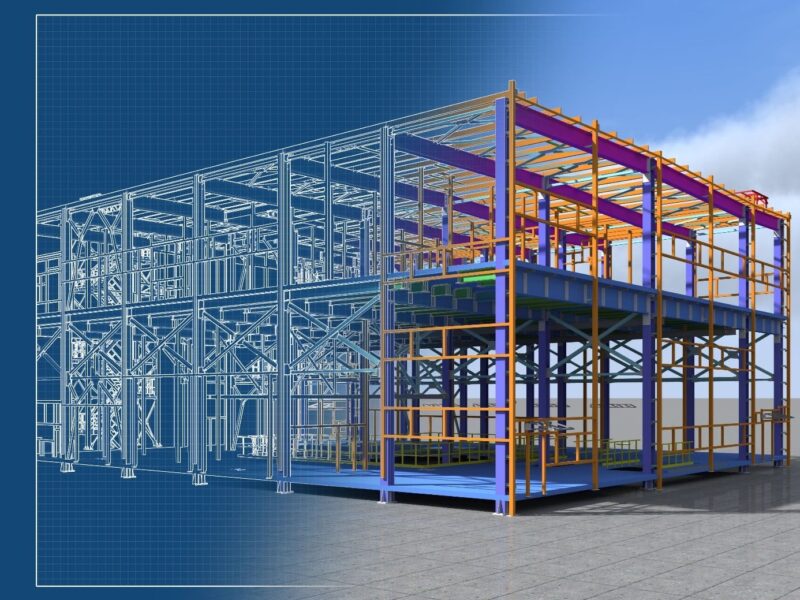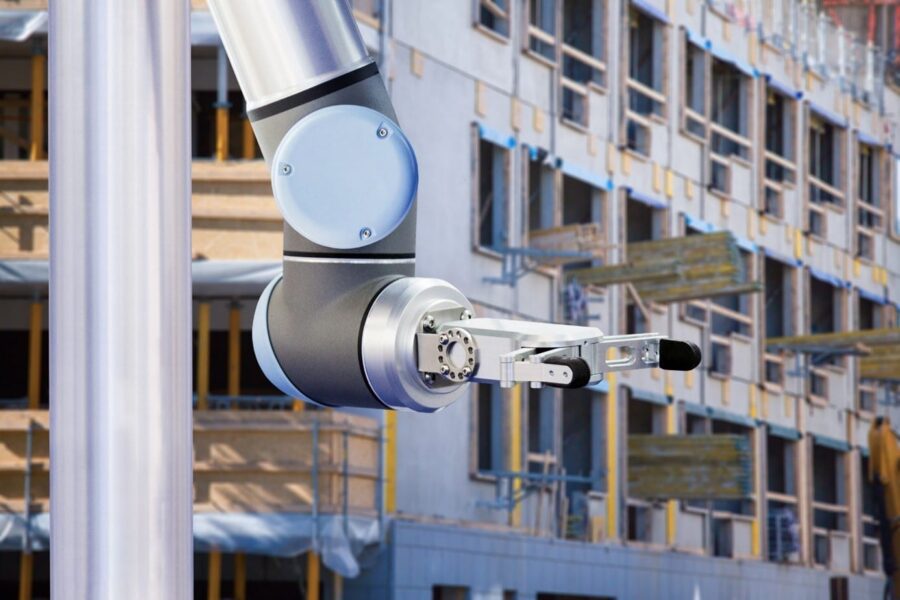DIGITALISATION IN Architecture, Engineering and Construction: HOW CONSTRUCTION IS GOING DIGITAL
Everything you need to know about technologies for Bauen 4.0, the right mindset for tackling digital transformation in Architecture, Engineering and Construction and the opportunities that the digital construction site offers.
BAUEN 4.0 – PLANNING & PROCESSES IN DIGITAL ARCHITECTURE, ENGINEERING AND CONSTRUCTION
Ongoing digitalisation in Architecture, Engineering and Construction primarily involves the design phase and work processes. Using new technologies offers significant advantages over analogue or static approaches, as shorter communication channels, digital modelling and precise resource planning streamline project management. Read on to find out about three trends in AEC digitalisation.
1. GIS DATA
A Geographic Information System (GIS) collects, analyses and stores spatial data for potential construction sites. This process generates virtual plans that can be superimposed on actual maps. Geoengineering has become an important component of many construction projects. Combining GIS with aerial, drone and satellite images and with other technologies can create more detailed maps of construction projects.
As Building Information Modelling (BIM) continues to gain traction, using GIS data during the construction process will become increasingly common, encouraged by new data capture technologies like LiDAR systems and laser scanners.
2. BIM – THE 5D SOLUTION FOR CONSTRUCTION PROJECTS
Put simply, BIM is a pioneering innovation that was developed specifically for construction and that is an essential component for the industry’s digital transformation.
BIM is a software process for combining, monitoring and managing the planning, design, construction and operation phases. Structuring multidisciplinary data supports efficient project management, so that architects, engineers and clients can agree on important standards before construction begins. A guide to BIM implementation planning helps teams to define workflows, determine weights and quantities digitally, and thus to conserve resources during construction. This includes both raw materials and time. Our interview examines how using 5D BIM impacts the project life cycle from a contractor’s perspective.

First and foremost, the documentation within the modelling software creates more transparent information flows, so performance and defect items can be tracked. This means that quality control can be applied throughout the project, guaranteeing results at a higher standard.
As there are numerous providers of construction software, several programs are normally used in a construction project. You can collate your results in a web application to maintain an overview. Your
employees can use any mobile device to send requests for information relating to challenges on the construction site straight to the architect or project leader, along with the location on the plan. The recipient can either respond immediately to the request or forward it to the specialist planners for further clarification.
3. COLLABORATION REGARDLESS OF LOCATION – DIGITAL WORK PROCESSES
The increased use of digital tools in the construction industry is changing how teams work together to deliver projects. Video conferencing, messaging applications and construction software have become an integral part of everyday life. Even complex concepts can be shared across devices and partially or fully unlocked for editing as needed.
Although cloud-based solutions underpin digital collaboration, the huge advantages of cross-site and synchronous cooperation are balanced out by a similar number of issues relating to security and data protection. Make sure that you have background knowledge on cloud systems so that you know what to look for when choosing a tool. In addition, approval procedures are now frequently carried out digitally. Learn what the difference is between digital signatures and document certifications and which authentication levels ensure that signatures are correct.
7 NEW TECHNOLOGIES FOR DIGITALISATION IN THE CONSTRUCTION INDUSTRY
As well as construction software that supports the full construction process, many technologies have been adapted specifically for use in construction in recent years. Learn which digital innovations have already been implemented and which ones are up and coming as part of digitalisation in the construction industry.
1. AUTONOMOUS VEHICLES
Autonomous driving predominantly uses technologies such as sensors, cameras, radars and artificial intelligence (AI) to cover a distance and/or complete a task without human intervention. Much has already been done in this area, in particular in Architecture, Engineering and Construction compared to other areas, as vehicles can be moved in a more controlled manner, which reduces risks.
Autonomous excavators, bulldozers, trucks and survey vehicles are already integrated into everyday operations in this industry. Consequently, workers are less likely to encounter potentially hazardous situations, safety standards are improved and productivity is increased through longer operating hours.
2. 3D PRINTING
Also known as additive manufacturing, 3D printing refers to processes where material is applied layer by layer to produce machine-made components or entire structures.
These processes were pioneered in other industries as a fast way to produce prototypes and are now catching on in construction. In the mid-2000s, 3D printers were capable of creating walls; nowadays, they can handle entire bridges or houses. The process facilitates rapid and safe construction with less waste and a larger design envelope.
Looking ahead, there is also the hope of using 3D printers to find sustainable alternatives to concrete. Laboratories are currently researching whether low-carbon production technology can be developed using local soil.
3. AUTOMATION & ROBOTICS
Using semi or fully automated robots to perform simple but labour-intensive tasks is becoming more commonplace in Architecture, Engineering and Construction. These robots are helping to compensate for the shortage of skilled workers and increase productivity, without completely replacing jobs.

Modular construction is an important field of activity. Rather than being produced on the construction site, parts of a building are manufactured or prefabricated in a factory and are then transported to the construction site for assembly. These can be small components such as panels, smaller mechanical and electrical components or even complete assemblies, which are then delivered by crane.
This approach reduces costs, time, risk and waste, while simultaneously increasing safety, quality and productivity. Although prefabrication is mainly used at the moment for the construction of private homes, opportunities to expand its applications are already being identified.
4. DRONES
Using drones pays dividends at various points on a construction site. Aerial photographs facilitate construction site logistics and quality control, as the images can be used to quickly track the progress of the construction project and also make the site safer for employees. Risky climbing is no longer needed to assess intermediate results; instead, documentation is recorded using camera technology, creating an objective basis for further decisions. You can read about the other advantages of drone photography in our article on drones on the construction site.
Incidentally, you can also use Bluebeam Revu to incorporate drone imaging. The major advantage of using the software is that images can be sent as PDF files, so you don’t have to switch back and forth between different formats.
5. ARTIFICIAL INTELLIGENCE
Artificial intelligence (AI) is also being used in many ways to support digitalisation in Architecture, Engineering and Construction. Wherever data is collected, AI can be used to analyse and streamline processes. As well as autonomous vehicles, a recent innovation is the use of AI for comprehensive coverage of construction sites. Learn how artificial intelligence is being used in construction project management to help meet project milestones.
6. AUGMENTED AND VIRTUAL REALITY
Augmented and virtual reality are mainly used in the design phase to visualise the intended construction project. They bring designs to life for customers, while misunderstandings can be resolved and streamlining achieved so that the final result also meets the client’s expectations. Read the interview with HawkinsBrown to discover the extent to which Virtual Reality represents a turning point in architecture.

7. 5G – THE DIGITAL CONSTRUCTION SITE
The new mobile communications technology is not yet widespread in Europe, and fast data transmission and synchronisation on the construction site itself are still dreams of the future. However, 5G network coverage has the potential to access large construction plans directly on site and monitor progress via camera. Diana Kightlinger tells you what advantages 5G would bring to the construction site.
SMART HOME – REAL-TIME DATA FOR SUSTAINABLE FACILITIES MANAGEMENT
Digitalisation is becoming increasingly relevant not only on the construction site itself, but also in the subsequent operation of a building. The reasons for this are obvious. Intelligent software offers safe, simple and economical solutions for facilities management, as well as a sustainable and efficient way of controlling lighting, heating, ventilation and air conditioning. Learn how real-time data drives the technology behind smart buildings and, in the spirit of the Internet of Things (IoT), boosts productivity while cutting costs. And we already have the first buildings where the data is being used to train AI to further optimise energy expenditure. For background information, read our article on Deep Learning For Building Management Systems.
Smart buildings use chips with radio frequency identification, which store data and create digital twins for the buildings. If digital twins in construction are to deliver meaningful results, they should be used in conjunction with BIM.
Tip: Get everyone on board with your project and work together toward a common goal. Bluebeam Revu will ensure that the whole team is up to date, from architects and contractors to artisans.
A CULTURE OF INNOVATION FOSTERS DIGITALISATION IN THE CONSTRUCTION INDUSTRY
First and foremost, digitalisation means switching from analogue to digital technologies. From communication methods and planning tools to devices and vehicles, entire industries are being comprehensively penetrated and revolutionised by digitalisation. At the same time, digital transformation is rooted in the attitude towards innovation rather than in the technology itself. Low-tech reforms in safety, management style or task distribution on the construction site prove that innovations start where technology ends.

CREATING SPACE FOR INNOVATION
Change is not a threat in a corporate culture that deliberately creates space for creativity and new ideas. Instead, the employees themselves pursue the goal of improving productivity, safety and quality. Foster an open culture in Architecture, Engineering and Construction to establish innovative ways of thinking. Find strategies for your team to engage with change and digital advances. Disruptive technologies will not pass a business by without leaving a trace and intact communication chains are the basis for effective cooperation. So, involving your staff in the decision-making process right from the start will reduce resistance and allow you to respond to reactions and suggestions.
RECOGNISING THE BENEFITS
To ensure that investing in a new technology is worthwhile, you should weigh up the costs and benefits in advance. We have compiled a checklist to help you find the right construction software for your business. In addition to the requirements for the software solution, you should have your target group in mind from the very beginning along with how you intend to introduce the solution. This will help you achieve a high ROI on new construction software.
CHANGE MANAGEMENT FOR SUCCESSFUL DIGITALISATION IN ARCHITECTURE, ENGINEERING AND CONSTRUCTION
An open corporate culture starts at the top. Management style plays a significant role in determining how much a team can identify with the company’s goal, buy into it, and accept predetermined changes. It is therefore important that employees are involved on a personal level, not just a technical one.
GOOD REASONS FOR CHANGE MANAGEMENT
Globalisation, technological advances, climate change and political and social change mean that the world is evolving ever more rapidly. So, it makes sense for businesses to adapt to change and to approach change strategically and proactively. Under these circumstances, change management has developed and proven itself as a leadership style. We will show you the arguments for change management.
IMPLEMENTING CHANGE MANAGEMENT
Using the five phases of Awareness, Desire, Knowledge, Ability and Reinforcement will allow you to successfully introduce your staff to a new tool and ensure they are motivated to implement it. Find out what the ADKAR process in change management is all about. You can also take advantage of the power of initiators in change management and find out why you are critical to success.
OPPORTUNITIES FOR DIGITALISATION IN ARCHITECTURE, ENGINEERING AND CONSTRUCTION
Architecture, Engineering and Construction is a highly complex economic sector with many players and various interest groups, all with their own requirements, dependencies and ways of working. This means that, rather than only affecting one trade, changes in Architecture, Engineering and Construction impact numerous parallel processes. This makes the introduction of new, digital structures more difficult. On the other hand, it also means that Architecture, Engineering and Construction would actually reap plenty of benefits from digitalisation. While Architecture, Engineering and Construction has lagged behind in terms of technology in many respects in recent years, the current pandemic is an opportunity to tackle digitalisation in the construction industry and switch to construction software, intelligent machines and sustainable production methods.

SAVING TIME
Digital software solutions have the potential to increase productivity in construction on several levels. Simplifying communication and construction coordination allows businesses to save both time and costs, as quantity surveys and calculations can be precisely recorded and implemented in close consultation. At the same time, accelerating these processes provides a significant competitive advantage. Read Tamás Márkus’ field report to find out how his construction company achieved a time saving of 50% thanks to Revu.
MODELLING BETTER PROCESSES
An associated side effect of using construction software is the opportunity to collect data across a range of construction projects and then use it to structure and analyse processes. This ensures that data in Architecture, Engineering and Construction contributes to decision making and supports the objectivity and standardisation of processes.
WORKING MORE PRODUCTIVELY
Digital innovations are also triggering revolutionary developments in the construction industry itself. Robotics in particular has significant potential, as automation boosts productivity in construction, increases safety and improves quality.
CHALLENGES FOR BAUEN 4.0
However, the tedious business of digitalising processes in Architecture, Engineering and Construction is not exclusively an internal problem; in many respects, construction companies are dependent on clients and investors. Innovative ideas from start-ups are pushed back so as not to jeopardise clients’ political goals, especially when it comes to large projects and government funding. Changes are needed here, from the tendering process onwards. The example of a global initiative for the infrastructure industry shows how this can work.
OUR SUMMARY OF DIGITALISATION IN ARCHITECTURE, ENGINEERING AND CONSTRUCTION
Digitalisation is an unstoppable process, that much is clear. Even though Architecture, Engineering and Construction is a complex network of different stakeholders, service providers and investors, with conservative work processes, critical voices and open questions about data protection, compatibility and feasibility, digital solutions will still become increasingly prevalent in the coming years. Each individual business is responsible for identifying best practices for its own team and individual needs, and for shaping digital transformation in the construction industry itself.
Join us at Bluebeam to take the next steps toward becoming a digital construction company. Contact us and we will be happy to discuss with you how your business can put construction software in place. Alternatively, attend one of our numerous events and webinars on digitalisation in construction to successfully tackle future challenges.
Image credit: title image © zephyr_p/stock.adobe.com, image 1 © HENADZ/stock.adobe.com, image 2 © scharfsinn86/stock.adobe.com, image 3 © ME Image/stock.adobe.com, image 4 © fotofabrika/stock.adobe.com, image 5 © NDABCREATIVITY/stock.adobe.com.











